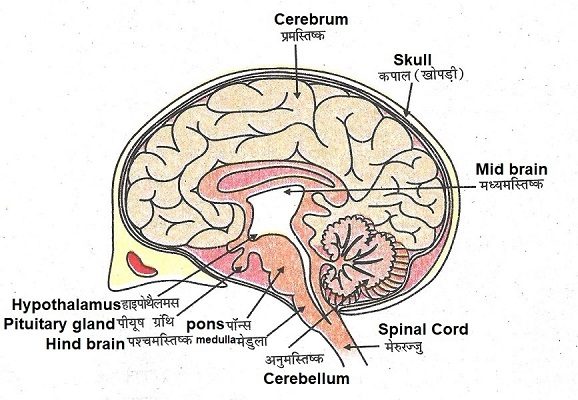प्रश्न 1. मानव मस्तिष्क का नामांकित चित्र बनाइए। संक्षेप में वर्णन कीजिए ?
Draw a labeled diagram of the human brain. Describe briefly?
उत्तर- मानव मस्तिष्क – यह एकअत्यन्त कोमल एवं महत्त्वपूर्ण अंग होता है। यह खोपड़ी के मस्तिष्क कोष में सुरक्षित रहता है। यह चारों ओर से दोहरी झिल्ली से घिरा होता है। बाह्य झिल्ली को दृढ़तानिका तथा भीतरी झिल्ली को मृदुतानिका कहते हैं। झिल्लियों के मध्य तरल भरा रहता है जो मस्तिष्क की प्रमस्तिष्क गोलार्द्ध सुरक्षा करता है।
मस्तिष्क के तीन प्रमुख भाग होते हैं-अग्र मस्तिष्क, मध्य मस्तिष्क तथा पश्च मस्तिष्क ।
1. अग्र मस्तिष्क के अन्तर्गत घ्राण पिण्ड, प्रमस्तिष्क तथा डाइएनसिफैलॉन आते हैं।
(i) घ्राण पिण्ड गन्ध ज्ञान के केन्द्र होते हैं।
(ii) प्रमस्तिष्क, स्मृति, सोचने, विचारने, चेतना, तर्क शक्ति,सीखने आदि क्रियाओं का केन्द्र होता है।
(iii) डाइएनसिफैलॉन अनैच्छिक क्रियाओं को नियन्त्रित करने का केन्द्र होता है, जैसे-भूख, प्यास, निद्रा, ताप नियमन, उपापचय नियमन आदि ।
2. मध्य मस्तिष्क का अधिकांश भाग अनुमस्तिष्क से ढका होता है। यह दृष्टि ज्ञान का केन्द्र होता है।
3. पश्च मस्तिष्क के अन्तर्गत अनुमस्तिष्क तथा मस्तिष्क पुच्छ आता है।
(i) अनुमस्तिष्क शरीर का सन्तुलन बनाये रखता है। पेशियों को नियन्त्रित करके गति (प्रचलन) को नियन्त्रित करता है।
(ii) मस्तिष्क पुच्छ शरीर की अनैच्छिक क्रियाओं जैसे श्वसन, हृदय स्पन्दन, रक्त परिसंचरण आदि का नियन्त्रण एवं नियमन करता है।

Human brain – It is a very soft and important organ. It remains safe in the brain sac of the skull. It is surrounded by a double membrane on all sides. The outer membrane is called tympanic membrane and the inner membrane is called tympanic membrane. There is a fluid filled between the membranes which protects the cerebral hemisphere of the brain.
There are three main parts of the brain – fore brain, midbrain and hindbrain.
1. The forebrain includes the olfactory bulb, cerebrum and diencephalon.
(i) Olfactory organs are the centers of smell sense.
(ii) Cerebrum, memory, thinking, consciousness, reasoning power, It is the center of activities like learning etc.
(iii) Diencephalon is the center for controlling involuntary actions, such as hunger, thirst, sleep, temperature regulation, metabolism regulation etc.
2. Most of the midbrain is covered by the cerebellum. This vision is the center of knowledge.
3. The hindbrain includes the cerebellum and the brainstem.
(i) Cerebellum maintains the balance of the body. Controls movement by controlling muscles.
(ii) The brain stem controls and regulates involuntary functions of the body like respiration, heart beat, blood circulation etc.




